

Here's Google's Secret to Hiring the Best People. “You never get a second chance to make a first impression” was the tagline for a Head & Shoulders shampoo ad campaign in the 1980s. It unfortunately encapsulates how most interviews work. There have been volumes written about how “the first five minutes” of an interview are what really matter, describing how interviewers make initial assessments and spend the rest of the interview working to confirm those assessments.
If they like you, they look for reasons to like you more. If they don’t like your handshake or the awkward introduction, then the interview is essentially over because they spend the rest of the meeting looking for reasons to reject you. These small moments of observation that are then used to make bigger decisions are called “thin slices.” This is How Coursera Competes Against Google and Facebook for the Best Talent. When John Ciancutti joined Netflix in 1999, he joined a team of four engineers.
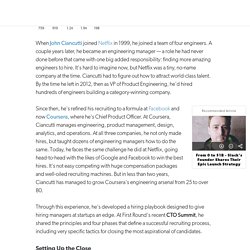
A couple years later, he became an engineering manager — a role he had never done before that came with one big added responsibility: finding more amazing engineers to hire. It's hard to imagine now, but Netflix was a tiny, no-name company at the time. Ciancutti had to figure out how to attract world-class talent. How I ended up conducting the most successful technical interviews with a single question. The hiring process A big part of my previous job was to take part in the hiring process and conduct technical interviews.
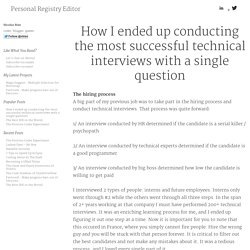
That process was quite forward: 1/ An interview conducted by HR determined if the candidate is a serial killer / psychopath 2/ An interview conducted by technical experts determined if the candidate is a good programmer 3/ An interview conducted by big boss determined how low the candidate is willing to get paid I interviewed 2 types of people: interns and future employees. The Anatomy of the Perfect Technical Interview from a Former Amazon VP. Neil Roseman is downright tired of hearing Silicon Valley companies say they “hire only the best and the brightest.”
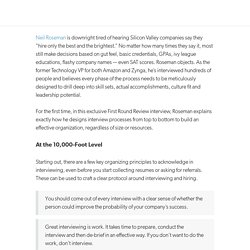
No matter how many times they say it, most still make decisions based on gut feel, basic credentials, GPAs, ivy league educations, flashy company names — even SAT scores. Roseman objects. As the former Technology VP for both Amazon and Zynga, he’s interviewed hundreds of people and believes every phase of the process needs to be meticulously designed to drill deep into skill sets, actual accomplishments, culture fit and leadership potential. For the first time, in this exclusive First Round Review interview, Roseman explains exactly how he designs interview processes from top to bottom to build an effective organization, regardless of size or resources.
HOW WE HIRE AT SNIPS — Snips Blog. When we think about how to build our team, the first thing we think about is the culture we want to create.
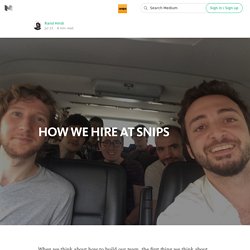
At Snips, we don’t see ourselves as a company with employees that have jobs, but rather as a community of passionate people. And together, we are working on our long term vision to fundamentally change the way we use technology in our everyday life. As such, our recruiting process puts a lot of emphasis on passion, team fit, creativity & hacker spirit. I won’t be covering how we built our talent dealflow. Rather, I will assume that there are already hundreds of applicants in the pipeline, all of whom seem to have the right qualifications.
Getting the Interview Phone Screen Right. The job market for software developers is hot.

This is great news for programmers, but it makes the interview process challenging for potential employers. A reader recently wrote me expressing some concern about the interview process: You mention Vertigo requiring a code sample, then a phone screening, then a hands-on test in the face-to-face. Five-essential-phone-screen-questions - steveyegge2. I've been on a lot of SDE interview loops lately where the candidate failed miserably: not-inclined votes all around, even from the phone screeners who brought the person in initially.
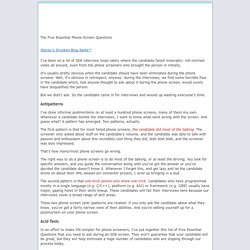
It's usually pretty obvious when the candidate should have been eliminated during the phone screens. Well, it's obvious in retrospect, anyway: during the interviews, we find some horrible flaw in the candidate which, had anyone thought to ask about it during the phone screen, would surely have disqualified the person. But we didn't ask. So the candidate came in for interviews and wound up wasting everyone's time. How to Hire a Programmer. There's no magic bullet for hiring programmers.
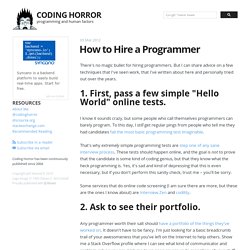
But I can share advice on a few techniques that I've seen work, that I've written about here and personally tried out over the years. 1. First, pass a few simple "Hello World" online tests. I know it sounds crazy, but some people who call themselves programmers can barely program. The Terrible Technical Interview. Traditional technical interviews are terrible for everyone.
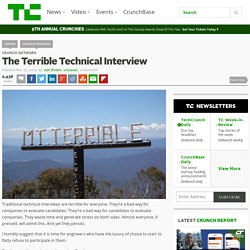
They’re a bad way for companies to evaluate candidates. They’re a bad way for candidates to evaluate companies. They waste time and generate stress on both sides. Almost everyone, if pressed, will admit this. The Technical Interview Is Dead (And No One Should Mourn) Allow me just a little self-congratulation.
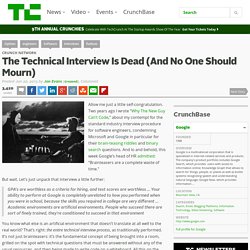
Two years ago I wrote “Why The New Guy Can’t Code,” about my contempt for the standard industry interview procedure for software engineers, condemning Microsoft and Google in particular for their brain-teasing riddles and binary search questions. And lo and behold, this week Google’s head of HR admitted: “Brainteasers are a complete waste of time.” But wait. Let’s just unpack that interview a little further: GPA’s are worthless as a criteria for hiring, and test scores are worthless … Your ability to perform at Google is completely unrelated to how you performed when you were in school, because the skills you required in college are very different … Academic environments are artificial environments. A Field Guide to Developers. By Joel Spolsky Thursday, September 07, 2006 Unfortunately, you can advertise in all the right places, have a fantastic internship program, and interview all you want, but if the great programmers don’t want to work for you, they ain’t gonna come work for you.
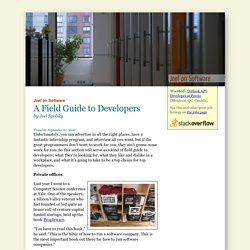
So this section will serve as a kind of field guide to developers: what they’re looking for, what they like and dislike in a workplace, and what it’s going to take to be a top choice for top developers. Private offices Last year I went to a Computer Science conference at Yale. The Guerrilla Guide to Interviewing (version 3.0) By Joel Spolsky Wednesday, October 25, 2006 A motley gang of anarchists, free-love advocates, and banana-rights agitators have hijacked The Love Boat out of Puerto Vallarta and are threatening to sink it in 7 days with all 616 passengers and 327 crew members unless their demands are met. The demand? A million dollars in small unmarked bills, and a GPL implementation of WATFIV, that is, the esteemed Waterloo Fortran IV compiler. (It’s surprising how few things the free-love people can find to agree on with the banana-rights people.) Fabulous Adventures In Coding. No one I know at Microsoft asks those godawful “lateral-thinking puzzle” interview questions anymore.
Maybe someone still does, I don’t know. But rumour has it that a lot of companies are still following the Microsoft lead from the 1990s in their interviews. In that tradition, I present a sequel to Keith Michaels’ 2003 exercise in counterfactual reasoning.